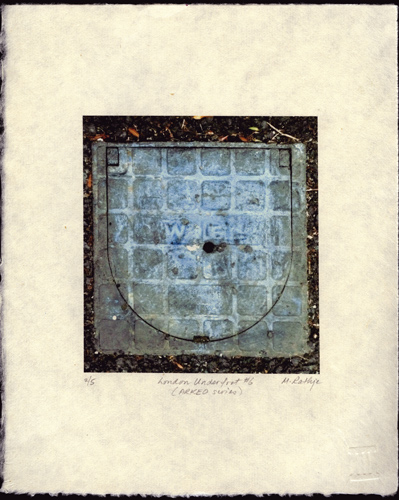street furniture

London Underfoot #6
The other day I posted about my series of prints called London Underfoot. I’m very gratified by the lovely reactions, including from my friend Jean, a Londoner. We have had a bit of an email chat about my use of the phrase ‘street furniture’ in describing those utility covers on the streets and walks of London which I had photographed and made into this series. Jean felt the phrase described only things like benches, mailboxes, lamp posts, that sort of thing – which is what I originally thought it meant as well. The first time I heard the term (and I had to search hard for that post!) was in comments to some photos I’d posted of drain covers here in my own neighbourhood in Vancouver.
Well, dear Jean went on to find and kindly send me two very interesting links, one with lots of photos and history of other London manhole covers and one about street furniture! I love those great designs in manhole covers and the fascinating history and most of all, this English language! As I wrote to Jean, some of the utility covers that I’d photographed were too small to be manholes, so there’s another intriguing thing! I now wish I’d made notes of each location of each metal plate that I’d photographed but at the time I didn’t know how this project was going to grow!
All this also made me recall a link I’d bookmarked a while back and which I finally found called drainspotting, about a book of photographs of Japanese manhole cover art which are truly amazing. One sure learns a lot on the ‘net!
January 20, 2011 in Arkeo, History, Photography, Printworks by Marja-Leena
The GPO link (and they should know) suggests that I was wrong about street furniture and Lucy is right that the term does include manhole covers.
The Spitalfields Life blog (manhole covers link) is a wonder that I only discovered recently and well worth exploring.
Thank you for the links. For once I much prefer the designs and lack of deliberate colour on our own UK utility access points.
Since it appears you’re quite charmed by this meaning of the word “furniture” let me bring further blessings and reveal that the phrase “door furniture” also exists, referring to brass keyholes, handles, letterbox surrounds and knockers (of the non-naughty sort).
Jean, the word ‘furniture’ to me doesn’t sound like it would include things that lie flat on the ground, like flooring or paving bricks or manhole covers. But that is the quirkiness of language and colloquialism. Yes, the Spitalfields blog is fascinating and I thank you again for finding it, and for our little discussion!
Olga, it struck me that the Japanese manhole covers look brand new. Surely those colours would wear off in traffic? Obviously, the historical and weathered look of the English ones appealed to me greatly.
BB, I’m intrigued by how meanings of a word can vary so much within one language. Door furniture is another new quirk to me, though I’m not sure what we’d call those as a group over here – hardware? accessories?
Oh my, the Japanese covers bring back memories. I wish I would photographed more, but I was without a camera the first two years living there. I wouldn’t be surprised if someone went around repainting them every so often to keep them looking vibrant. I have to admit that the weathered look appeals to me though.
Rouschswalwe, it wouldn’t surprise me either if the manholes covers were repainted regularly. Just curious, how many years did you live in Japan?
This was an absolutely wonderful idea for a project and very beautifully done too.
I’ll show them to my husband tomorrow and take him for a little visit to the Tokyo page too.
Susan, thanks, glad you like it, and hope your husband enjoys the link!
I first heard the phrase ‘street furniture’ when I was teacher training and it was suggested as a source of art projects ‘in the field’ for children, that you didn’t have to be in a picturesque setting to find subjects for art. I gathered it was any kind of fittings that you might find, furniture in the sense of things furnished, ‘movables’.
Anyway, what you’ve done with these is really stunning; they were interesting to begin with but now they’re beautiful.
Lucy, thanks for enlightening us on your first experience with the phrase. I suppose these covers are in a sense movable. And thanks for the kind words about my work!